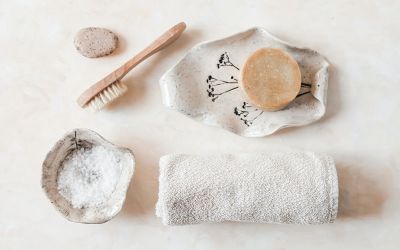There are many ways to create a cozy home without relying on cranking up the thermostat during the colder months, which is particularly important with energy prices continuing to rise and the increasing need to reduce our environmental impact. It's about crafting a warm ambiance that embraces you as soon as you step through the door, and using cost-effective, efficient heating solutions to better utilise your spaces.
In this guide we'll share our favourite hacks on how to keep your house warm in winter, from cozy decor tips to cheap ways to heat a room that will infuse your home with warmth, even when the temperature drops.

Charterhouse Bianco Antique-effect Porcelain
Block cold drafts
Heat loss in the home often stems from common issues such as drafty windows and gaps between old floorboards or skirting boards – all of which are particularly frequent occurrences in older properties.
Whether you're renovating or considering a brand-new extension, your choice of flooring can affect the heating and comfort of your home greatly, so it’s important to invest in a quality product. When it comes to retaining heat, porcelain tiles are a great low-maintenance option, and will prove to be a cost-effective option over time, while natural stone tiles are highly durable, quick to heat, and will of course block any cold drafts from coming up through your floors.
While upgrading your windows or flooring is often the most effective long-term solution, there are also many effective quick fixes to help you combat the cold drafts in the meantime – such as:
- Large rugs and thermal curtains are one of the cheapest ways to heat a room without central heating by acting as a barrier against drafts and retaining heat within a room.
- Consider swapping slatted blinds for heavy-duty, full-length curtains and size up your rugs to keep your spaces cosy.

Efficient heat distribution
To make the most of your home’s warmth, it's crucial to ensure your main heat sources aren't obstructed by furniture, as this impedes temperature circulation around the room. If your spaces are too tight to move large furniture, consider positioning a secondary electric heater on the other side of the room for better heat distribution. An alternative, which is especially effective in open-plan living areas is underfloor heating, which ensures even heat dispersion throughout your home.
Kitchens, in particular, tend to be built on exterior walls or in shady areas of the property, making them subject to colder temperatures - especially in older, poorly insulated houses. To avoid the sizeable job of re-insulating walls or relocating your kitchen, underfloor heating serves as a practical and less invasive solution.
By transforming the entire kitchen floor into a primary heat source, this method offers consistent, evenly distributed warmth, creating a warm under-foot experience that feels very cosy and luxurious. Read our guide if you need help finding the best tiles for underfloor heating.

Consider your colour palettes
Blues, whites, and greens are incredibly popular colours within interiors, known to add a sense of freshness and tranquillity into a space. However, if used wrongly, these shades can make your home feel very stark and cold.
To avoid this, steer clear of palettes featuring entirely cooler hues like bright whites, pale blues and chromes or silvers. Instead, look at introducing warm accents to balance the overall look, such as brass fittings, a beige stone floor, or wooden furniture.

Left: Amalfi Gold Polished, Right: Amiata Gris
Or, better still, sidestep cold colours entirely by embracing warmer shades such as caramel, rust, pink, ochre, or beige, which have an instantly warming and welcoming feel within a home, and are bang on trend! Even within typically cooler colour families like greens, blues and whites, you can consider yellow or red based hues such as olive green, ivory or teal blue. When used to envelop a space, these subtle warm undertones can feel very cosy and cocooning as a decor choice.

Left: Salcombe Rose Crackle Metros, Right: Cavendish Teal Metros
Use texture in furniture and materials
To infuse warmth into your home, consider the impact of material choices. Not only can the right furniture materials make your home feel visually warmer, but they can also improve physical heat retention.
Natural elements like wood and rattan exude warmth visually, whereas fabrics hold the ability to absorb and retain heat. Opting for upholstered furniture over faux-leather or metal frames will mean your spaces retain heat for much longer, while also offering a softer, cosier touch.
While minimalism has dominated interior design trends over the past few years, removing too much from a space or failing to incorporate varied textures can lead to your home feeling bare and uninviting. Incorporating textural layering within your home enhances visual coziness, building depth and character, while also boosting insulation, effectively retaining heat. Think chunky throws, large rugs, plush cushions, and even table linens.

Left: Calacatta Hex Gold, Right: Travertino Light Antique-effect
Upgrade your lighting
Lighting is one of the most instantly effective techniques, for anyone wondering how to make a room warmer. Create a cosy atmosphere by building up multiple sources of soft lighting through side lamps, candles, or wall sconces, and avoid harsh over-head lighting.
Sufficient lighting in a kitchen is, of course, a key factor to consider here. However, replacing grids of overhead lighting with a mix of pendants, wall lights and under-cabinet lighting will give your kitchen a much more balanced overall feel, while remaining practical. Dimmer switches are also a great addition within an open-plan kitchen, to give you full control by easily switching from functional to ambient moods when required.
Most importantly, be sure to consider the colour temperature of your bulbs throughout your home. A simple change to some low kelvin bulbs, around 2000K-3500K, will instantly make your surroundings feel warmer, while offering sufficient, practical lighting that doesn’t feel overwhelming.

Left: Wentworth Flower, Right: Menton Tumbled Limestone
Plants, accessorising, and adding character
As the minimalist trend recedes, we’re desiring to embrace more personality and warmth within our interiors, by creating a style that resonates with you as an individual.
Home design is very personal, and therefore must mirror your stylistic and emotional choices. If a space doesn’t reflect you, your personality, and your preferences, it will be hard to connect with, and can feel very emotionally cold. Inject character through meaningful touches, such as a vase of flowers, cherished photos, framed artwork, or creative decor to enliven your space.
Adding plants, potted herbs, or fresh flowers into your home brings a sense of vibrancy and vitality, with natural elements adding a welcoming, familiar warmth - not to mention the various health benefits that make your home a nurturing and uplifting environment, enhancing your overall well-being.

Left: Babylon Olive, Right: Vogue Gris
There are plenty of ways to make your home feel warmer in the colder seasons, from home upgrades to simple tips and tricks, with decor and tile selection being one of the most important considerations. For guidance on how to install and care for your tiles, explore our tiling advice, or keep up to date with further design ideas and inspiration on the Stone Superstore blog.



